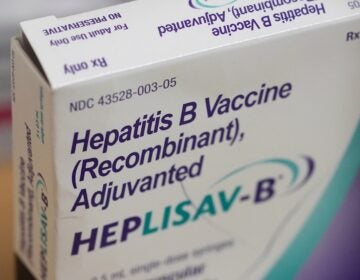Camden Sears building demolition part of a bigger plan for a business park
When Campbell Soup Co. began demolishing the historic Sears building on Camden’s Admiral Wilson Boulevard last week, the striking of machinery to concrete marked the end of one long process and the start of another.
The journey to take ownership of the building, abandoned by Sears in 1971 and neglected or underutilized ever since, had taken Campbell more than six years and endless rounds in court. The voyage to turn the parcel on which the structure has sat since 1927 into a modern office park could take every bit as long.
“We certainly have more work to do to bring this vision to life,” said Anthony Sanzio, vice president of global communications, minutes before demolition. “It’s going to be a long-term process.”
For starters, it will take eight weeks to bring down the building that’s stood in the way of Campbell’s development plans since before February 2007, when then-CEO Douglas Conant and former Governor Jon Corzine announced the expansion of the Fortune 500 company’s corporate headquarters and the construction of what’s called the “Gateway Office Park.”
But it isn’t until after the Sears building occupies nothing more than memory that the hardest work truly gets underway. As master redeveloper of the 60-acre site that envelops its corporate campus on two sides, Campbell doesn’t plan to retain ownership of the property or take charge of designing, building or leasing it. Instead, the company is seeking to turn over the land, perhaps parcel by parcel, to any credible entity that presents a viable plan for its conversion to office space. According to Sanzio, that could take years.
Wanted: Developer for free land
“A lot’s changed. The economy has changed, the commercial real estate market has changed,” he said.So while it may seem that free land five minutes outside Philadelphia would make for an irresistible investment, market conditions are creating a scarcity of corporations that want to erect new workspaces in Camden or developers interested in building a multi-tenant structure on spec. So Campbell, together with the New Jersey Economic Development Authority and various city-based agencies, is now re-intensifying its efforts to market Phase One – a ten acre subplot where the Sears building will stand for just over another month.
So far, executives at the food conglomerate have contracted an architectural firm to draw up renderings; met with every major developer and commercial real estate agency in the region; hosted several large meetings at their campus; conducted presentations at relevant conferences, and networked … a lot.
Although Campbell and EDA representatives have spent years engaged in these and similar activities, they’re now revisiting old prospects who wouldn’t express any serious interest while the Sears building disrupted the continuity of the site.
“People don’t like uncertainty,” surmises Sanzio. “It would be very challenging to say, ‘I’m going to invest into a project next to a building that has been vacant and in a state of disrepair for several decades.'”
Campbell has spent a total of $132 million dollars so far on its corporate expansion – completed in 2010 – and the preparation, marketing and legal wrangling required for the Gateway site. This figure includes $10 million to acquire and dispense with several unwanted buildings and lots, with $3.5 million spent to buy Sears.
What’s in it for Campbell Soup?
Why is Campbell laying out so much money to receive no direct compensation in return? The answer, said Sanzio, is part benevolence and part business.
“This is the gateway, the first impression you get of the city when you’re coming in,” he said. “Ultimately we want to make a difference here and do what we can to help revitalize the city. But think about what the Campbell campus looked before our expansion. It was surrounded by a chain link fence and barbed wire. Now it’s a much more inviting place and that makes a huge difference when you’re recruiting candidates.”
When recruiting business and development, a welcoming aesthetic does make a difference — but not as much as the financial incentive package. According to Maureen Hassett, senior vice president of finance and development for the EDA, the site qualifies for numerous state tax incentives. Some calculate rewards based on the number of jobs created or retained when a company either opens for business in New Jersey or opts to stay in-state rather than relocating elsewhere. Others, thanks to Camden’s designation as one of nine New Jersey Urban Hubs, provide assistance with capital investments and buy down leases.
And still others reward high-tech companies for moving to Camden, one of three state-designated “innovation zones” set up in university towns to encourage collaboration between industry and academia. The Gateway Office Park lies approximately one mile from downtown Camden, which is home to a medical school, a future nursing school, four colleges and universities and several major health care centers, has emerged as a center for highly advanced biotech research and development.
Hassett and Sanzio both hope the office park will lure entrepreneurs who can help facilitate the vertical integration of these valuable assets and further stimulate the city’s economy.
“The development of Gateway Office Park really is a milestone for the expansion of real redevelopment activity from the city’s downtown core to the surrounding areas,” Hassett says. “It really is a new day in Camden.”
WHYY is your source for fact-based, in-depth journalism and information. As a nonprofit organization, we rely on financial support from readers like you. Please give today.








